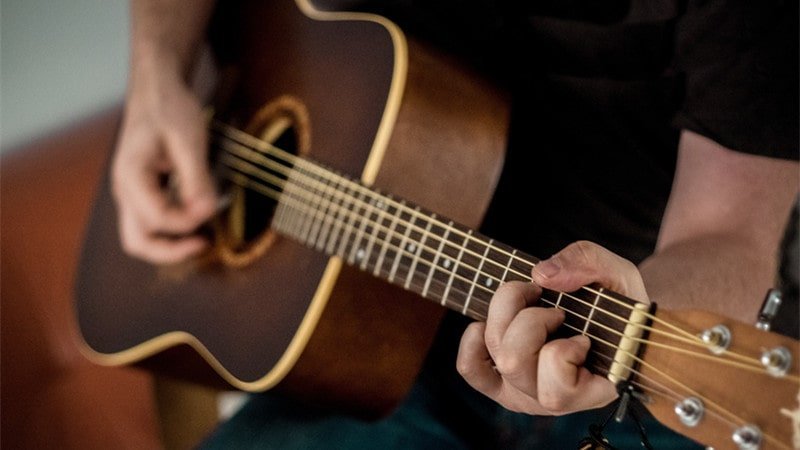Practice makes perfect, especially when it comes to playing guitar.
If you want to become an intermediate player right away, you need to focus on classical guitar exercises for beginners.
Here are five of them:
1. Learning Guitar Parts
Before you try all the exercises below, it’s best to master the classical guitar parts first.
As a beginner, you need to familiarize yourself with the following:
Guitar Strings
Classical guitars come with a letter or note name and string numbers.
The thinnest string, which is near the floor, is number 1. It progresses to the thickest string, which is number 6.
On the other hand, the note name goes in the opposite direction—from the thickest to the thinnest string (EADGBE).
To remember these note values for the nylon strings, memorize these mnemonics:
• Eddie Ate Dynamite, Good Bye Eddie
• Elephants And Dogs/Donkeys Grow Big Ears
• Every American Dollar Goes Back East
• Every Acid Dealer Gets Busted Eventually
Frets
These horizontal lines are the metal cross pieces located on the guitar’s neck.
They’re numbered, with 0 corresponding to the open string. From here, the frets are named 1 and so forth. This Fender Stratocaster is also a good choice if you are looking for a new guitar.
Tuning Keys
These pegs are located on the guitar’s headstock.
When you tighten the different strings, the pitch will go up. When you loosen them, the pitch will go down.
Should you need to tune your guitar, you can always use an app on your phone.
But if you want to do this manually, you can make an open string sound like another note. This should help the guitar tune itself.
2. Classical Music Theory
As a budding musician, you need to be interested in music theory.
For starters, all you need to do is remember the word FACE. It spells the letters on the staff.
Next, you need to memorize these notes:
• Whole note or semibreve
• Half note or minim
• Quarter note or crotchet
• Eighth note or quaver
• Sixteenth note or semiquaver
When you see dotted notes, it means the note increases by half its value.
3. Left-Hand Exercises
Before you proceed with this classical guitar exercise, you need to memorize the finger names first.
The fingers are named 1 to 4—from your pointer finger to your little finger. The thumb has no number, though some call it 0 or T.
Fixed Fingers Practice Session
As an absolute beginner, it’s crucial to build finger strength. One way to do it is through this session.
It involves three fingers, which you need to lock in place while the other fingers jump around.
Start by having 2, 3, and 4 fixed down on the 6th, 7th, and 8th fret. This will allow your finger to play from the first to sixth strings and back again.
After doing so, swap your fingers so that 2, 3, and 4 are the ones moving.
4. Right-Hand Exercises
Similar to the guitar lesson above, you need to memorize the names of your right-hand fingers.
Since the right hand is often used to play classical guitar, the finger names are derived from the Spanish language:
• Thumb - Pulgar
• Index finger - Indice
• Middle - Medio
• Ring- Anular
• Little- Chiquito
Now that you’re familiar with the names, it’s time to warm them up first before you start with your online lessons.
Use your joints to curl and spread your fingers. Try to bend and curl the middle joint fingers as well.
Once your fingers are warmed up, you can go ahead with this first lesson:
Hula Wave Practice Lessons
With your hand flat, curl your fingers up. The tips should lead the movement to create a wave movement.
If you’re feeling some warmth in your fingers, it means the exercises are working.
Rasgueados or Spanish Strum Classical Guitar Technique
If you want to control your right hand more, you should try doing classical guitar lessons.
To perform the Rasgueados, you need to push your fingers across and out of your palm.
If you try to do it with your flamenco guitar, you’ll come up with a loud yet explosive harmony.
5. Sheet Music Sight Reading
If you want to learn classical guitar music right away, you need to work on your sight-reading skills.
Simply put, it’s an exercise where you play guitar notes upon seeing them.
When it comes to reading music, you have to make sure that your eyes are moving forward. Keep on going, even if you miss some of the half notes.
Next, aim to play at least 60% to 80% of the piece. Remember: you’re beginning classical guitar lessons right now, so don’t be disheartened if you don’t get everything perfect right away.
Once you get 80% of the technique book correct, it’s time to speed up your metronome. On the other hand, you can try and go ahead with the new free lessons.
Final Thoughts
While you may not sound good at first, you’ll fare better eventually, just like your idol guitarists.
The most important thing to remember is that practice makes progress. Just do more and more exercises each day, and you’ll improve in no time.



